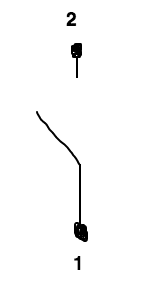This is my first post here so I won't take offense in any restructuring, closing, migrating...
- Project description
I have a tank of water, and its level is always decreasing (for all intents and purposes, it's like it's leaking). I have a pump constantly adding water into this tank. I want to make sure the tank never overflows (I can't tell in advance how fast water will leak, and pump rate is constant).
- Materials
So I have a Eltako MFZ61DX-UC delay relay and a float switch (tiny plastic floater that closes the circuit based on water level). What I want to do is quite simple: when water gets too high, stop the pump for 30 seconds so that water level lowers.
The float switch can be placed in either direction, meaning it's either always open, and closes when water gets too high, or it's always closed and opens when water gets too high. That's easy. But it's also important to delay so that the pump doesn't just keep turning off and back on again when water level is close to the float switches level.
That's where the relay comes in. It has several delay functions to choose from (and more info can be found on its notice):
- Question
Based on this 1 page notice for the relay, is this doable? Looking at the 6 modes of this relay, it looks like all you can do is temporarily turn on something, not temporarily turn it off. Am I misunderstanding this? Is there some way to wire it so that it'd work?
I have never used a relay but I feel like logically, it should switch between 2 circuits (and not just open and close one), but if that's the case, this notice doesn't make a good job telling me how to wire this whole thing.
If I can oversimplify my question with 2 simple drawings: the notice indicates two terminals for the relay (1 & 2 on the drawing on the left), but I'd like to know where is the third one (3 on the drawing on the right).
- Bonus question
In case the first question doesn't work out, can someone point me towards a relay that can actually do what I want here?
For the lazy amongst you, here's a "typical wiring" of this relay, found on the notice. With that and everything else provided before, you should have enough info to answer my question without looking through the notice.





